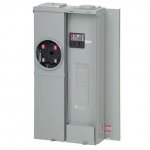RustyShackleford
Senior Member
- Location
- NC
- Occupation
- electrical engineer
My jurisdiction allows line-side taps, as well as back-fed circuit breakers, for connecting a grid-tied solar inverter.
They also allow interlock kits (in the main load center) for generator inlets.
If using both a back-fed breaker for the PV inverter, AND an interlock kit for the generator inlet, it seems that a hazard exists. During generator usage, the interlock prevents both the main breaker and the breaker for the generator inlet from being turned on at the same time. However, it'd still be necessary to remember to turn off the back-fed PV breaker; otherwise the generator and the PV inverter could be connected to each other (via the load center busbars) with unexpected and probably bad results.
Is there any way for a back-fed PV inverter connection to co-exist with a generator inlet, other than using a critical-loads sub-panel for the generator ? There are no interlock kits I'm aware of that work with three breakers (the main breaker, the generator-inlet breaker, and the PV-inverter breaker).
They also allow interlock kits (in the main load center) for generator inlets.
If using both a back-fed breaker for the PV inverter, AND an interlock kit for the generator inlet, it seems that a hazard exists. During generator usage, the interlock prevents both the main breaker and the breaker for the generator inlet from being turned on at the same time. However, it'd still be necessary to remember to turn off the back-fed PV breaker; otherwise the generator and the PV inverter could be connected to each other (via the load center busbars) with unexpected and probably bad results.
Is there any way for a back-fed PV inverter connection to co-exist with a generator inlet, other than using a critical-loads sub-panel for the generator ? There are no interlock kits I'm aware of that work with three breakers (the main breaker, the generator-inlet breaker, and the PV-inverter breaker).


